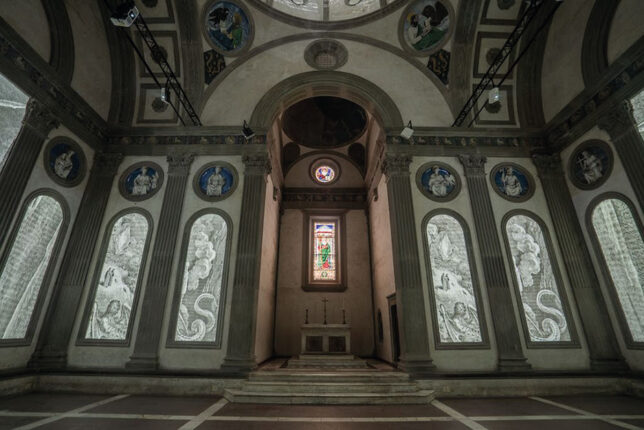Dante. The Eternal Poet by Felice Limosani. Surrounded by Gustave Doré’s illustrations in the Pazzi Chapel
by Joanna Plotkin December 22, 2021
Posters hung around Florence featuring Dante’s dour profile invite the public to come visit the “immersive exhibit” in the Pazzi Chapel at Santa Croce, created by artist Felice Limosani. The posters provide little descriptive information; all the visitor knows is that the exhibit celebrates Dante, the Eternal Poet. In a Dantean city remembering the poet 700 years after his death, his image is ubiquitous, and the posters fade into the background. The informational panels about the exhibit in the ticket line at Santa Croce and outside the Pazzi Chapel itself do little to prepare the visitor for the experience inside. In reality, it is the music that gives the first indication that something special is happening within the chapel. Once the visitor steps out of the church and into the cloister, they are drawn down the stairs by the medieval strains emanating from behind the curtain that obscures the entrance to the chapel. The curtain blocks light from entering the room, but also creates a barrier that, when pushed aside, gives the visitor the sense of entering a reverential space. Indeed, the exhibit is a religious one. It is a journey through Dante’s Divine Comedy, as illustrated by Gustave Doré. In a cycle that lasts around twenty minutes, Doré’s brilliant etchings are projected on the walls accompanied by music selected for each cantica. But the illustrations are not static, as Doré imagined them. Limosani has brought them to life, animating the images and adding effects that make the viewer question how they could have ever been motionless. Hands gesture, clouds part, angels swirl. Rain falls and lightning flashes. In Dante’s Hell, there is no music. In Limosani, baritone voices accompany Dante and Virgil through the nine circles. In Purgatory, one hears a sung Mass in which a single note held on an organ creates a sense of suspense. This time, female voices bring the register up, indicating an ascent from Hell. The music in Paradise, inspired by the compositions of Hildegard of Bingen, brings the journey to a triumphant end. Visitors curious about the music, all original compositions, can read about it on discreet screens that provide information in both Italian and English. The exhibition was designed with the Pazzi Chapel in mind, but it almost seems as if the chapel itself were built for Limosani’s project. Considered one of Brunelleschi’s masterpieces, the chapel’s bare decoration belies its complex geometric design. The acoustics of the building allow sound to ring out and surround the listener, perfectly matching the larger-than-life illustrations projected on the pietra serena walls. There are even projections on the dome which show the sky changing throughout the poets’ journey. The exhibition, on view through January 10, will live on through Harvard University’s Digital Collections. In fact, Limosani optimized the images for television screens, laptops, and tablets, in order to make the project available as a didactic tool. Although the digitization of Limosani’s work is a laudable next step in Dante’s “journey from parchment to pixel,” it is hard to imagine it existing anywhere but its current home in the Pazzi Chapel.
The Italian version of the article can be found at this link at the Florence Is You magazine’s website.
